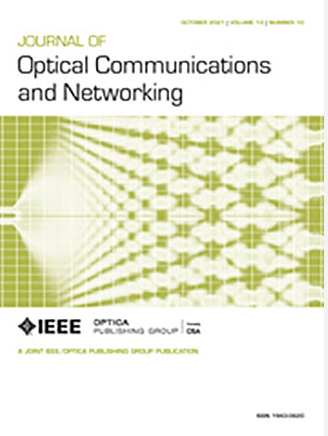数字FSO前传网络的环境感知几何整形
IF 4.3
2区 计算机科学
Q1 COMPUTER SCIENCE, HARDWARE & ARCHITECTURE
引用次数: 0
摘要
自由空间光通信(FSO)作为最后一英里接入网解决方案之一,能够满足6G前传网络快速增长的流量需求。然而,室外FSO传输必须面对大气条件的影响;雾和乱流更值得注意。为了抵抗雾和湍流对光信号幅度分布的影响,我们提出了一种环境感知的信号幅度几何整形(GS)方案,用于四电平脉冲幅度调制(PAM-4)的FSO前传网络。FSO网络通过能见度和温度传感器来感知由雾和湍流引起的信道状态,从而避免了反馈链路的需要。该算法基于环境感知的信道状态信息,自适应确定PAM-4的最优电信号幅度,以在不同信道条件下最小化平均误码率(BER)。利用环境模拟室对能见度和湍流对PAM-4信号幅值的影响进行了理论模拟和实验评估。据我们所知,我们首次通过实验证明了环境感知GS在对抗能见度和湍流对FSO传输性能的影响方面的有效性。实验结果表明,与采用均匀振幅分布的传统PAM-4相比,GS算法的平均误码率降低了1/3。本文章由计算机程序翻译,如有差异,请以英文原文为准。
Environment-aware geometric shaping for digital FSO fronthaul networks
As one of the last-mile access network solutions, free-space optical (FSO) communication can satisfy the rapidly growing traffic demand of 6G fronthaul networks. However, outdoor FSO transmission has to confront the influence of atmospheric conditions; fog and turbulence are worth more attention. To resist the impact of fog and turbulence on the distribution of optical signal amplitudes, we propose an environment-aware geometric shaping (GS) of signal amplitudes scheme for FSO fronthaul networks with four-level pulse amplitude modulation (PAM-4). The FSO networks are aware of channel states caused by fog and turbulence through visibility and temperature sensors to avoid the need for feedback links. Based on the environment-aware channel state information, the proposed GS algorithm determines adaptively the optimal electrical signal amplitudes of PAM-4, aiming to minimize the average bit error rate (BER) under the varying channel conditions. The effects of visibility and turbulence on PAM-4 signal amplitudes are theoretically modeled and experimentally evaluated using an environmental simulation chamber. For the first time, to the best of our knowledge, we demonstrate experimentally the effectiveness of the environment-aware GS in combating the effects of visibility and turbulence on FSO transmission performance. Experimental results show that the GS algorithm can reduce the average BER by 1/3 compared to the traditional PAM-4 using uniform amplitude distribution.
求助全文
通过发布文献求助,成功后即可免费获取论文全文。
去求助
来源期刊
CiteScore
9.40
自引率
16.00%
发文量
104
审稿时长
4 months
期刊介绍:
The scope of the Journal includes advances in the state-of-the-art of optical networking science, technology, and engineering. Both theoretical contributions (including new techniques, concepts, analyses, and economic studies) and practical contributions (including optical networking experiments, prototypes, and new applications) are encouraged. Subareas of interest include the architecture and design of optical networks, optical network survivability and security, software-defined optical networking, elastic optical networks, data and control plane advances, network management related innovation, and optical access networks. Enabling technologies and their applications are suitable topics only if the results are shown to directly impact optical networking beyond simple point-to-point networks.

 求助内容:
求助内容: 应助结果提醒方式:
应助结果提醒方式:


